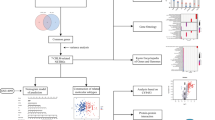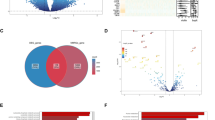Abstract
Evidence indicates that exposure to heavy trace element might be a risk factor for liver carcinoma. Cadmium has been supposed to be a carcinogen that has a correlation with the risk of a number of cancers, including liver cancer. However, the mechanisms underlying Cadmium-induced malignant transformation in liver cells are not fully understood. In the present study, we aimed to screen the differentially expressed genes (DEGs) that might play a role in both the Cadmium-related liver cell transformation and the development of liver cancer. Microarray-based gene expression profiles concerning liver carcinoma vs non-cancerous tissue (GSE64041) and Cadmium-treated liver cells vs controls (GSE8865 and GSE31286), respectively, were retrieved from Gene Expression Omnibus (GEO) database. Then, DEGs of each profile were calculated and screened. The intersection of each DEGs was obtained by Venn analysis. Afterwards, the possible roles of the selected genes in cancer development were evaluated by using Oncomine database and TCGA cohort analysis. Consequently, three DEGs, LRAT, SLC7A11, and ITGA2, were selected for further analysis. SLC7A11 and ITGA2, but not LRAT, were upregulated in liver cancer compared with those in normal tissues, respectively. After using a TCGA cohort analysis, results failed to show a significant correlation between SLC7A11 or ITGA2 expression and clinical parameters. However, the survival analysis showed that patients with high expression levels of SLC7A11 had a shorter overall survival time relative to those of the patients with low levels. In conclusion, SLC7A11 and ITGA2 might play a role in the Cadmium-induced liver cell damage or transformation, and the development of liver carcinoma. SLC7A11 might be a prognostic factor for patients with liver carcinoma. Future validation experiments are needed to verify the results.




Similar content being viewed by others
References
Lin H, Ha NB, Ahmed A, Ayoub W, Daugherty TJ, Lutchman GA, Garcia G, Nguyen MH (2013) Both HCV and HBV are major causes of liver cancer in Southeast Asians. J Immigr Minor Health 15(6):1023–1029. doi:10.1007/s10903-013-9871-z
Moudgil V, Redhu D, Dhanda S, Singh J (2013) A review of molecular mechanisms in the development of hepatocellular carcinoma by aflatoxin and hepatitis B and C viruses. J Environ Pathol, Toxicol Oncol 32(2):165–175
Niu ZS, Niu XJ, Wang WH (2016) Genetic alterations in hepatocellular carcinoma: an update. World J Gastroenterol 22(41):9069–9095. doi:10.3748/wjg.v22.i41.9069
Hong YS, Song KH, Chung JY (2014) Health effects of chronic arsenic exposure. J Prev Med Public Health 47(5):245–252. doi:10.3961/jpmph.14.035
Hsu LI, Wang YH, Hsieh FI, Yang TY, Wen-Juei Jeng R, Liu CT, Chen CL, Hsu KH, Chiou HY, Wu MM, Chen CJ (2016) Effects of arsenic in drinking water on risk of hepatitis or cirrhosis in persons with and without chronic viral hepatitis. Clin Gastroenterol Hepatol 14(9):1347–1355e4. doi:10.1016/j.cgh.2016.03.043
Garry MR, Santamaria AB, Williams AL, DeSesso JM (2015) In utero arsenic exposure in mice and early life susceptibility to cancer. Regul Toxicol Pharmacol 73(1):378–390. doi:10.1016/j.yrtph.2015.07.023
Fujishiro H, Yano Y, Takada Y, Tanihara M, Himeno S (2012) Roles of ZIP8, ZIP14, and DMT1 in transport of cadmium and manganese in mouse kidney proximal tubule cells. Metallomics 4(7):700–708. doi:10.1039/c2mt20024d
Koedrith P, Kim H, Weon JI, Seo YR (2013) Toxicogenomic approaches for understanding molecular mechanisms of heavy metal mutagenicity and carcinogenicity. Int J Hyg Environ Health 216(5):587–598. doi:10.1016/j.ijheh.2013.02.010
Garcia-Esquinas E, Pollan M, Tellez-Plaza M, Francesconi KA, Goessler W, Guallar E, Umans JG, Yeh J, Best LG, Navas-Acien A (2014) Cadmium exposure and cancer mortality in a prospective cohort: the strong heart study. Environ Health Perspect 122(4):363–370. doi:10.1289/ehp.1306587
Chen C, Xun P, Nishijo M, He K (2016) Cadmium exposure and risk of lung cancer: a meta-analysis of cohort and case-control studies among general and occupational populations. J Expo Sci Environ Epidemiol 26(5):437–444. doi:10.1038/jes.2016.6
Song J, Luo H, Yin X, Huang G, Luo S, Lin du R, Yuan DB, Zhang W, Zhu J (2015) Association between cadmium exposure and renal cancer risk: a meta-analysis of observational studies. Sci Rep 5:17976. doi:10.1038/srep17976
Zhang L, Zhu Y, Hao R, Shao M, Luo Y (2016) Cadmium levels in tissue and plasma as a risk factor for prostate carcinoma: a meta-analysis. Biol Trace Elem Res 172(1):86–92. doi:10.1007/s12011-015-0576-0
Ledda C, Loreto C, Zammit C, Marconi A, Fago L, Matera S, Costanzo V, Fuccio Sanza G, Palmucci S, Ferrante M, Costa C, Fenga C, Biondi A, Pomara C, Rapisarda V (2017) Non-infective occupational risk factors for hepatocellular carcinoma: a review (review). Mol Med Rep 15(2):511–533. doi:10.3892/mmr.2016.6046
Franken C, Koppen G, Lambrechts N, Govarts E, Bruckers L, Den Hond E, Loots I, Nelen V, Sioen I, Nawrot TS, Baeyens W, Van Larebeke N, Boonen F, Ooms D, Wevers M, Jacobs G, Covaci A, Schettgen T, Schoeters G (2017) Environmental exposure to human carcinogens in teenagers and the association with DNA damage. Environ Res 152:165–174. doi:10.1016/j.envres.2016.10.012
Suzuki M, Takeda S, Teraoka-Nishitani N, Yamagata A, Tanaka T, Sasaki M, Yasuda N, Oda M, Okano T, Yamahira K, Nakamura Y, Kobayashi T, Kino K, Miyazawa H, Waalkes MP, Takiguchi M (2017) Cadmium-induced malignant transformation of rat liver cells: potential key role and regulatory mechanism of altered apolipoprotein E expression in enhanced invasiveness. Toxicology 382:16–23. doi:10.1016/j.tox.2017.03.014
Shimoda R, Achanzar WE, Qu W, Nagamine T, Takagi H, Mori M, Waalkes MP (2003) Metallothionein is a potential negative regulator of apoptosis. Toxicol Sci 73(2):294–300. doi:10.1093/toxsci/kfg095
Qu W, Fuquay R, Sakurai T, Waalkes MP (2006) Acquisition of apoptotic resistance in cadmium-induced malignant transformation: specific perturbation of JNK signal transduction pathway and associated metallothionein overexpression. Mol Carcinog 45(8):561–571. doi:10.1002/mc.20185
Barrett T, Wilhite SE, Ledoux P, Evangelista C, Kim IF, Tomashevsky M, Marshall KA, Phillippy KH, Sherman PM, Holko M, Yefanov A, Lee H, Zhang N, Robertson CL, Serova N, Davis S, Soboleva A (2013) NCBI GEO: archive for functional genomics data sets--update. Nucleic Acids Res 41(D1):D991–D995. doi:10.1093/nar/gks1193
Yu JW, Mai W, Cui YL, Kong LY (2016) Genes and pathways identified in thyroid carcinoma based on bioinformatics analysis. Neoplasma 63(4):559–568. doi:10.4149/neo_2016_409
Rhodes DR, Kalyana-Sundaram S, Mahavisno V, Varambally R, Yu J, Briggs BB, Barrette TR, Anstet MJ, Kincead-Beal C, Kulkarni P, Varambally S, Ghosh D, Chinnaiyan AM (2007) Oncomine 3.0: genes, pathways, and networks in a collection of 18,000 cancer gene expression profiles. Neoplasia 9(2):166–180
Lenci RE, Rachakonda PS, Kubarenko AV, Weber AN, Brandt A, Gast A, Sucker A, Hemminki K, Schadendorf D, Kumar R (2012) Integrin genes and susceptibility to human melanoma. Mutagenesis 27(3):367–373. doi:10.1093/mutage/ger090
Liu X, Liang Z, Gao K, Li H, Zhao G, Wang S, Fang J (2016) MicroRNA-128 inhibits EMT of human osteosarcoma cells by directly targeting integrin alpha2. Tumour Biol 37(6):7951–7957. doi:10.1007/s13277-015-4696-0
Ferraro A, Boni T, Pintzas A (2014) EZH2 regulates cofilin activity and colon cancer cell migration by targeting ITGA2 gene. PLoS One 9(12):e115276. doi:10.1371/journal.pone.0115276
Ding W, Fan XL, Xu X, Huang JZ, Xu SH, Geng Q, Li R, Chen D, Yan GR (2015) Epigenetic silencing of ITGA2 by MiR-373 promotes cell migration in breast cancer. PLoS One 10(8):e0135128. doi:10.1371/journal.pone.0135128
Shaikhibrahim Z, Lindstrot A, Buettner R, Wernert N (2011) Analysis of laser-microdissected prostate cancer tissues reveals potential tumor markers. Int J Mol Med 28(4):605–611. doi:10.3892/ijmm.2011.746
Wong KF, Liu AM, Hong W, Xu Z, Luk JM (2016) Integrin alpha2beta1 inhibits MST1 kinase phosphorylation and activates yes-associated protein oncogenic signaling in hepatocellular carcinoma. Oncotarget 7(47):77683–77695. doi:10.18632/oncotarget.12760
Drabovich AP, Pavlou MP, Schiza C, Diamandis EP (2016) Dynamics of protein expression reveals primary targets and secondary messengers of estrogen receptor alpha signaling in MCF-7 breast cancer cells. Mol Cel Proteomics 15(6):2093–2107. doi:10.1074/mcp.M115.057257
Robert SM, Buckingham SC, Campbell SL, Robel S, Holt KT, Ogunrinu-Babarinde T, Warren PP, White DM, Reid MA, Eschbacher JM, Berens ME, Lahti AC, Nabors LB, Sontheimer H (2015) SLC7A11 expression is associated with seizures and predicts poor survival in patients with malignant glioma. Sci Transl Med 7(289):289ra286. doi:10.1126/scitranslmed.aaa8103
Polewski MD, Reveron-Thornton RF, Cherryholmes GA, Marinov GK, Cassady K, Aboody KS (2016) Increased expression of system xc- in glioblastoma confers an altered metabolic state and Temozolomide resistance. Mol Cancer Res 14(12):1229–1242. doi:10.1158/1541-7786.MCR-16-0028
Wang F, Yang Y (2014) Suppression of the xCT-CD44v antiporter system sensitizes triple-negative breast cancer cells to doxorubicin. Breast Cancer Res Treat 147(1):203–210. doi:10.1007/s10549-014-3068-6
Drayton RM, Dudziec E, Peter S, Bertz S, Hartmann A, Bryant HE, Catto JW (2014) Reduced expression of miRNA-27a modulates cisplatin resistance in bladder cancer by targeting the cystine/glutamate exchanger SLC7A11. Clin Cancer Res 20(7):1990–2000. doi:10.1158/1078-0432.CCR-13-2805
Shiozaki A, Iitaka D, Ichikawa D, Nakashima S, Fujiwara H, Okamoto K, Kubota T, Komatsu S, Kosuga T, Takeshita H, Shimizu H, Nako Y, Sasagawa H, Kishimoto M, Otsuji E (2014) xCT, component of cysteine/glutamate transporter, as an independent prognostic factor in human esophageal squamous cell carcinoma. J Gastroenterol 49(5):853–863. doi:10.1007/s00535-013-0847-5
Kinoshita H, Okabe H, Beppu T, Chikamoto A, Hayashi H, Imai K, Mima K, Nakagawa S, Ishimoto T, Miyake K, Yokoyama N, Ishiko T, Baba H (2013) Cystine/glutamic acid transporter is a novel marker for predicting poor survival in patients with hepatocellular carcinoma. Oncol Rep 29(2):685–689. doi:10.3892/or.2012.2162
Sasaki H, Sato H, Kuriyama-Matsumura K, Sato K, Maebara K, Wang H, Tamba M, Itoh K, Yamamoto M, Bannai S (2002) Electrophile response element-mediated induction of the cystine/glutamate exchange transporter gene expression. J Biol Chem 277(47):44765–44771. doi:10.1074/jbc.M208704200
Author information
Authors and Affiliations
Corresponding author
Ethics declarations
Conflict of Interest
The authors declare that they have no conflict of interest.
Ethical Approval
This article does not contain any studies with human participants or animals performed by any of the authors.
Rights and permissions
About this article
Cite this article
Zhang, L., Huang, Y., Zhu, Y. et al. Identification and Characterization of Cadmium-Related Genes in Liver Carcinoma. Biol Trace Elem Res 182, 238–247 (2018). https://doi.org/10.1007/s12011-017-1106-z
Received:
Accepted:
Published:
Issue Date:
DOI: https://doi.org/10.1007/s12011-017-1106-z




